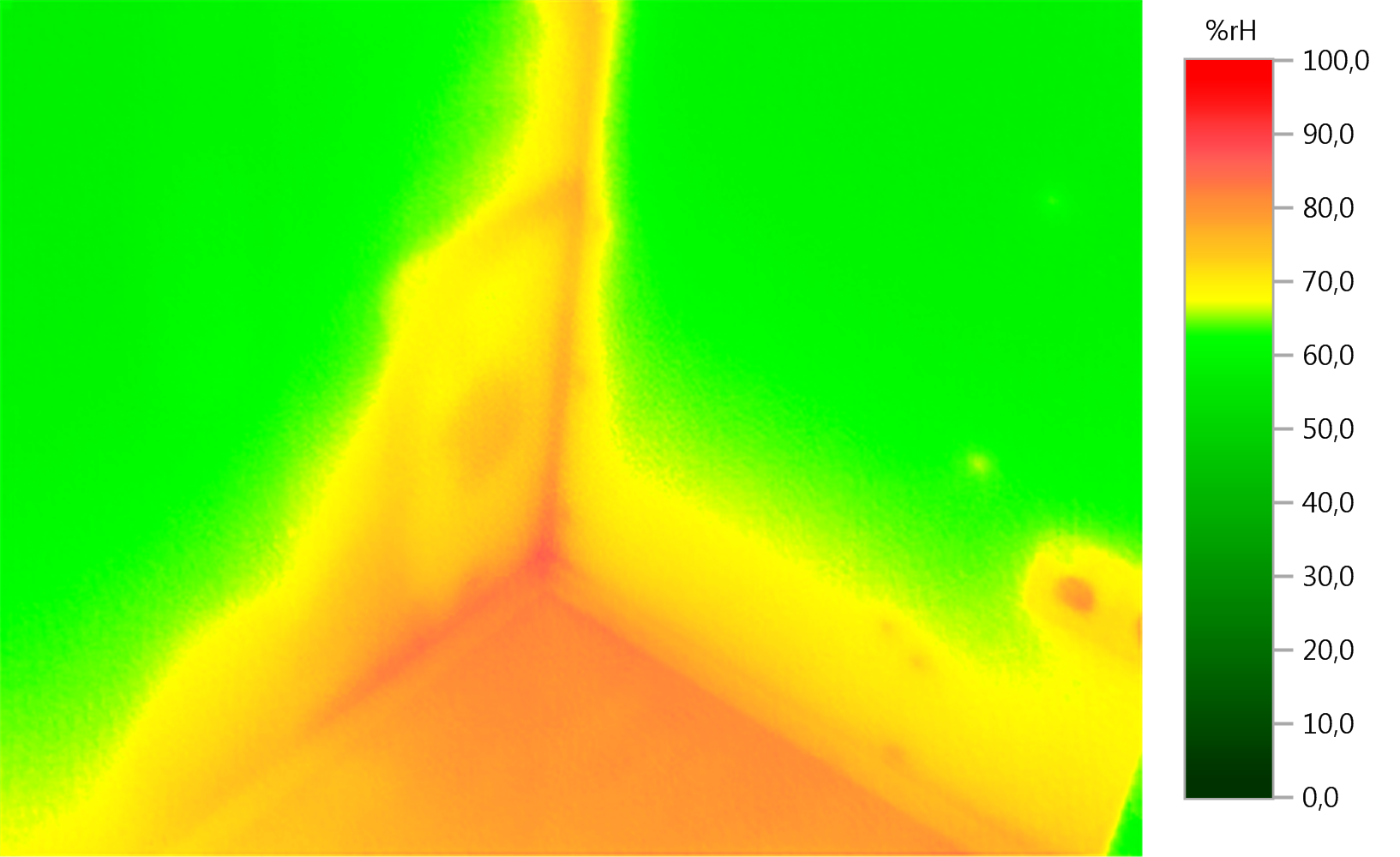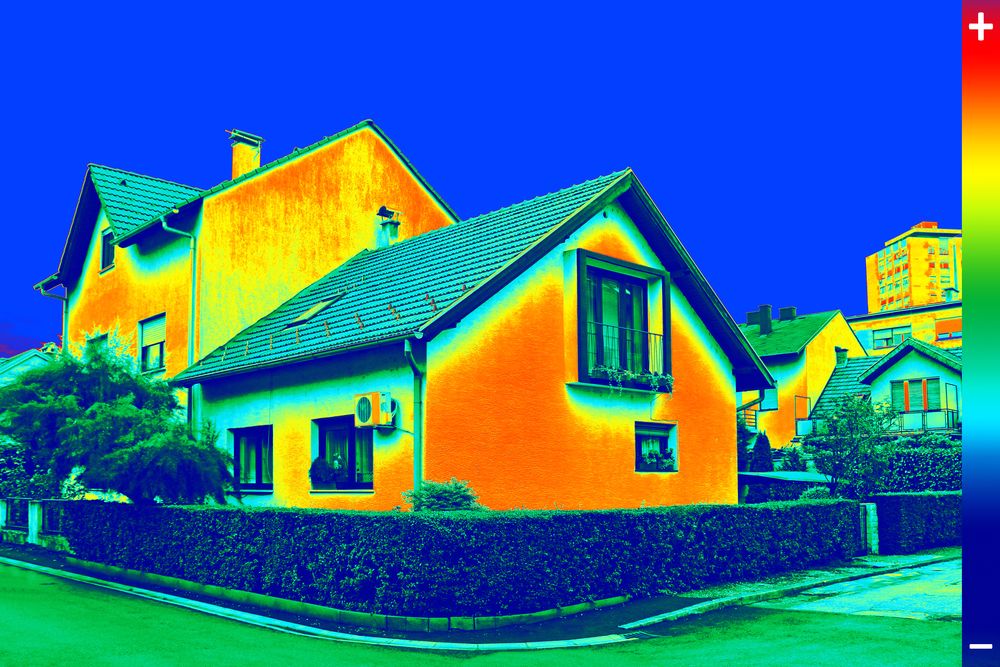Since the COVID-19 pandemic began, infrared thermometers have been more widely used. We see them in restaurants, music venues, museums and more. They offer a quick and easy way to tell if someone has a fever just by checking the surface temperature of their forehead or wrist.
Infrared (IR) thermometers have been an important piece of technology since far before the pandemic. They are used to monitor the safety of food and drugs, and they can find dangerous problems — like mould — in a home or building.
But how can technicians find the information they need with surface temperature alone?
The importance of measuring surface temperature
Surface temperature is a useful indicator of quality. Some instances where surface temperature is important to assess and record are:
Consumable goods
Businesses that sell food — restaurants, grocery stores and service — need to ensure that the products they offer are safe for consumption. One effective method for doing so is taking the temperature of incoming goods as well as cooked food.
For businesses that sell food in any capacity — whether prepared, packaged or otherwise — the organisation must have a thermometer that is accurate to 1 degree, according to Food Standards Australia New Zealand (FSANZ).
These companies can test the temperature of their food with a penetration thermometer in many cases. However, there are instances where penetrating the food items would damage the quality. For example, packaged foods need to stay completely sealed, so using a penetration thermometer could compromise quality and discourage customers from making a purchase.
In these cases, an infrared thermometer is the ideal device. It takes the surface temperature as opposed to the internal temperature, which still gives business owners the information they need to ensure the food item is in the acceptable temperature range.
Home inspections
Surface temperature measurements also come in handy for home inspections. Infrared thermometers can spot problems from the outside of a wall or ceiling without needing to penetrate the surface to inspect what’s behind it. Some important issues in a home — like mould, foundational problems or even rodent or termite infestations — radiate warmer or cooler temperatures than their surroundings.

Body temperature*
Before the COVID-19 pandemic, when you thought about taking your body temperature, you probably pictured an oral thermometer or one that goes in your ear. However, now that public places like restaurants, schools, museums and more are required to record temperature measurements of the patrons entering their establishments, there needs to be a more sanitary way to take many people’s temperatures.
Enter the infrared solution, a non contact thermometer. This device is a forehead thermometer that takes a temperature measurement from a few inches away from the person’s face. It never has to come into contact with an individual before displaying its temperature readings. This is much safer than expecting hundreds or even thousands of people to use penetrative thermometers.
However, it’s essential that these IR thermometers provide accurate temperature readings. If they are inaccurate by even a couple of degrees, someone with symptoms of COVID-19 could be allowed in a public space and spread the disease widely.
For this reason, the Australian Government Department of Health introduced a new law that requires the Therapeutic Good Administration (TGA) to approve all temperature measuring medical devices before they can be used by organisations for COVID-19 screening. This is in response to many reported inaccuracies in temperature measurement. High quality products are important now more than ever.
Now that we understand how surface temperature data comes into play, let’s talk about how infrared thermometers work.
Infrared radiation, defined
Infrared radiation, or infrared light, is a part of the electromagnetic spectrum that humans cannot see, but can sometimes feel, according to NASA. When humans feel infrared radiation, it is in the form of heat. When the infrared waves are weak, humans can’t feel them at all, but they are still there.
Think about when someone has a fever. You can’t feel the high temperature radiating from their skin from a distance. However, if you touch their forehead or cheek, you can often feel that it’s warmer than usual. It also would be impossible to see heat waves coming off of a person’s skin, no matter how high their fever is.
An IR thermometer, on the other hand, can detect infrared radiation. By pointing the device at someone or something from an appropriate distance, it can pick up on light waves that the human eye is incapable of seeing. The device then displays the temperature readings, giving the user of the IR thermometer the information they need about the quality of the item or the temperature of the person.
But how do these infrared waves move from the person or object to the device? The answer is emissivity.
How infrared thermometers use emissivity
Before we can get into how infrared thermometers use emissivity, let’s define what exactly emissivity is.
Emissivity is the magnitude at which an entity emits infrared radiation, according to ScienceDirect. This amount is determined by comparing the thermal energy emitted by the body in question to that of a surrounding blackbody. A blackbody is a theoretical construct that absorbs all infrared radiation, and therefore emits none.
In short, a non contact infrared thermometer determines how much thermal energy an entity is radiating by assessing the emissivity of that body.
But does everything emit infrared radiation in the same way?
How emissivity varies
Different materials absorb and emit varying amounts of infrared radiation. Remember, infrared radiation is a type of light, and it works the way other kinds of light on the electromagnetic spectrum do.
Think of walking on black asphalt with bare feet versus walking on light-coloured concrete. When these materials bake in the sun, they feel different to the touch, even though they are existing under the same conditions. A dark, asphalt material absorbs and then emits more infrared radiation than a lighter coloured material. If you’ve ever stepped from a cement footpath onto an asphalt road with bare feet, you may have suddenly felt an uncomfortably hot or burning sensation on the bottoms of your feet. That’s because different materials have different emissivity levels.
The importance of the correct emissivity setting
Emissivity can be a difficult concept to grasp because it’s not a phenomenon that can be seen or even necessarily felt. That’s why the accuracy of the device assessing emissivity is so important. To ensure accuracy, not only does a technician have to have a high-quality device, but the settings used to achieve accurate results must be carefully selected.
Although the IR thermometer is an ideal instrument for measuring temperature, certain aspects also have to be considered:
- Infrared radiation and emissivity are different. Both need to be taken into account to get accurate temperature readings. Testo laser thermometers have a stored emissivity table.
- IR thermometers may vary in functionality depending on their surroundings. For example, in cool surroundings, an IR thermometer requires a certain acclimatisation time.
- The accuracy of an IR thermometer depends on the distance at which it’s used. Do not stand too far away from the object in question, otherwise the measurement will be inaccurate.
Keeping all of these considerations in mind — along with using high-end technology — is the best way to ensure accurate temperature readings.
When it comes to assessing the safety and quality of consumable products, conducting thorough home inspections and taking body temperatures during a pandemic, there is little room for error in calculating emissivity. To practice an abundance of caution, technicians should also consider calculating the emissivity of bodies in question manually.
Manually calculating emissivity
Under ideal conditions, a high-quality infrared thermometer will likely display accurate temperature readings. However, it never hurts to double check your work, especially when health and safety are on the line.
You can calculate emissivity manually by using an IR thermometer to gather data about the infrared radiation of the body in question as well as that of a neighbouring blackbody. Once these two figures are obtained, you simply divide the figure from the body being measured by the blackbody. The result is the emissivity of the body in question.
How to use an infrared thermometer
Infrared thermometers are not difficult to use. You simply point the thermometer at the object or being whose temperature you wish to take, and the screen will show a temperature reading. That being said, it’s important to perform this action under ideal conditions and with the right technique.
A temperature measuring instrument such as an infrared thermometer is precise, safe and easy to operate. With a couple of useful tips and tricks, you can achieve even better measurement results:
- The right model: To begin with, there is the most important question of all: what type of temperature measuring instrument do you need? Is a model with laser sufficient, or do you also have to measure core temperatures using a penetration thermometer?
- Risk of mould: Detecting mould requires a special solution. In this case, we recommend either the Smart Probes from Testo or the testo 835-H1 with a special humidity module.
- Acclimatisation time: Before starting measurement, the acclimatisation time first has to be taken into account. This is the time that is needed until the thermometer has adjusted itself to the ambient temperature. This can take some time in cool rooms in particular.
- Emissivity: Virtually every object emits radiation. This is represented by the emissivity. The emissivity of each measurement object must be set before measurement. Testo IR thermometers have a stored emissivity table. This simplifies operation even further.
- Measurement spot: Depending on the distance of the measuring instrument from the measurement object, a specific measuring range is recorded. This is the measurement spot. The measurement object should always be larger than the measurement spot specified in the documentation of the measuring instrument in order to prevent undesirable influences from the marginal area.
Infrared thermometers from Testo
There are various options available for measuring temperature using infrared radiation. In addition to traditional thermometers, pyrometers (also known as laser thermometers or IR thermometers) are proven instruments for measuring temperature.
Testo’s solutions
An IR thermometer from Testo offers you the following
- An instrument for the fast, non contact measurement of the surface temperature.
- Easy temperature measurement, even with dynamic processes or in locations that are difficult to access.
- Reliable temperature measurement with cost-effective technology.
Over 60 years ago, Testo launched its very first product — an electronic thermometer. This experience in developing innovative temperature measuring instruments can now be seen in the testo 835-H1, the ultimate tool for non contact temperature measurement.
The high-precision, safe and robust testo 835-H1 has the following features:
- 4-Point-Laser showing the exact measuring zone, effectively preventing wrong measurements.
- 50:1 optics that provide you with excellent surface temperature measurements even over greater distances (distance 5 m = 10 cm measurement spot).
- Adjustable degree of emission for measuring a wide variety of surfaces.
- Connectivity for temperature sensors: for additional contact measurements for materials with low degree of emission possible – simply connect your optionally available temperature sensor.
We also offer the testo 830-T1, an efficient and high-tech infrared thermometer. This device includes the following capabilities:
- Easy-to-handle gun design.
- An audio and visual alarm.
- Backlit display.
- Adjustable emissivity from 0.2 to 1.0.
- 10:1 optics and high resolution processor for accurate measurement results.
Not only is it important to us that you have the best quality products, but it’s also our top priority that they are calibrated properly. That’s why we offer a full calibration range on all infrared devices — even non-testo ones.
Testo’s courses
We also want to make sure you know how to use our high-tech devices. They are safe and easy to use, but a little guidance goes a long way.
For that reason, we offer a Testo Introduction to IR Measurement Course. With our help, you can learn how to use our products — or others — in the most effective way possible.
For more information on our infrared thermometers, services or IR courses, contact us today.
* Note: IR thermometers from Testo are designed for industrial use and they are not medically graded instruments.









 Reduce cooking oil costs while ensuring quality
Reduce cooking oil costs while ensuring quality Expert knowledge on CO2 monitoring
Expert knowledge on CO2 monitoring Refrigeration knowledge - in 3 modules
Refrigeration knowledge - in 3 modules



